Published: August 28, 2024 | Last Updated on: August 28, 2024 | by Hema
Diastasis Recti is a common condition in postpartum women – here’s what you need to know about what it looks like and how to tackle it.
Jump To hide Your Complete Guide to Diastasis Recti What is Diastasis Recti Abdominis? Causes for Diastasis Recti Symptoms of Diastasis Recti Diagnosis of Diastasis Recti Exercises to fix Diastasis Recti 1. Diaphragmatic breathing 2. Abdominal bracing 3. Pelvic tilts 4. Umbrella Breathing with Kegel 5. Pelvic tilts on all fours 6. Kneeling leg and arm extension 7. Side plank 8. Heel taps with weights 9. Leg lifts 10. Glute bridge Other tips to heal Diastasis Recti Prevention of Diastasis Recti Treatment of Diastasis Recti Buy Healthy Nutritious Baby, Toddler food made by our own Doctor Mom !One thing I loved doing during pregnancy was checking how big my baby was getting. The fruit comparisons were fun – “your baby is as big as a grapefruit”!
Of course, by the end of it, I was super exhausted and wanted my watermelon-sized baby out! While the big baby belly is gone then, postpartum Moms are still left with a little bump that settles down with time.
⭐ Download FREE Recipe Ebooks for Babies & Toddlers

However, in some cases, the bump doesn’t go away, and one possible reason for it is diastasis rectus abdominis, where the rectus abdominis muscles which get separated during pregnancy fail to get back to their original position.
If you suspect this may have happened to you, let’s find out by learning more about the condition.
Your Complete Guide to Diastasis Recti

What is Diastasis Recti Abdominis?
Diastasis Recti Abdominis, also called DRAM or diastasis recti, is diastasis of rectus abdominis muscles. These are long muscles that run vertically down the belly, from the chest to the pelvis. They lie in front of the stomach and just below the skin, and are what are commonly referred to as ‘six-pack abs’.
The muscles are divided into left and right sides, separated by connective tissue called the linea alba. When you get pregnant, all the muscles and tissues in the abdomen stretch and expand to accommodate the growing baby, including the rectus abdominis and linea alba.
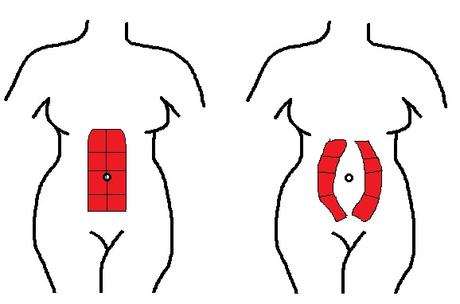
After childbirth, the muscles and tissues begin their healing process. They’re quite elastic in nature and get back to their original positions soon enough. However, sometimes the tissues are stretched so much that they lose their elasticity and don’t come back together. This condition is known as diastasis recti.
Diastasis recti may occur in the third trimester, although it is visible only postpartum. It is estimated that about 60% of all pregnant women get diastasis recti, with more than half of all cases getting resolved within six months. There are a few reasons that make some women more prone to getting diastasis recti than others.
Causes for Diastasis Recti
- Multiple pregnancies close to each other
- Multiple babies in a single pregnancy, like twins or triplets
- Delivering big babies
- Vaginal delivery
- Being short in height and/or overweight
- Being over 35 years old
Symptoms of Diastasis Recti
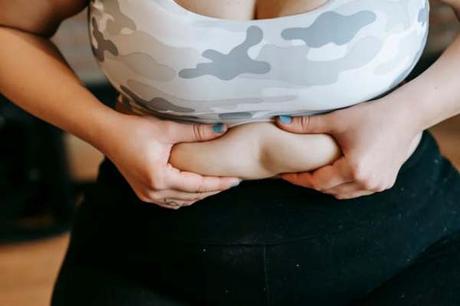
While diastasis recti may start in the third trimester, the symptoms are only visible after childbirth. The most common symptom is the belly sticking out – giving the appearance of being pregnant several months after giving birth. Here are more symptoms in detail:
- A belly pooch that begins around the area of the belly button
- Persistence of the tummy bulge despite losing weight
- Extra softness around the belly button, like jelly
- Doming of abdominal muscles on contraction
- Difficulty or weakness when doing everyday tasks like lifting objects
- Pain in the lower back, hip or pelvis
- Poor or weak posture
- Stress incontinence; leaking of urine when sneezing, coughing or laughing
- Bloating and constipation
- Painful intercourse
Sometimes these symptoms may be confusing – do you really have diastasis recti? You can find out either by doing a home test or visiting the doctor.
Diagnosis of Diastasis Recti
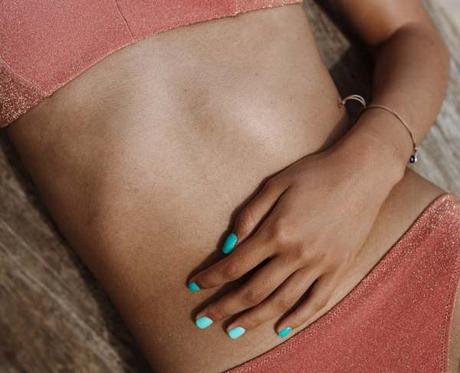
An easy way to check for diastasis recti is a self-examination at home. Here’s how to go about it:
- Lie on your back with your knees bent and feet flat on the floor
- Anchor your lower back and lift your shoulders and upper back slightly, as if crunching your abs
- In this position, push down into the center of your stomach with two fingers – just above the belly button, at the belly button and just below it – you may notice a gap between the muscles
- See how many fingers fit between your left and right ab muscles – if you feel like there’s more than a two-finger width of space between your abdominal muscles, you may have diastasis recti
You can confirm the diagnosis by visiting your doctor, who will use their fingers as well as a tool called caliper to measure the gap between your abdominal muscles.
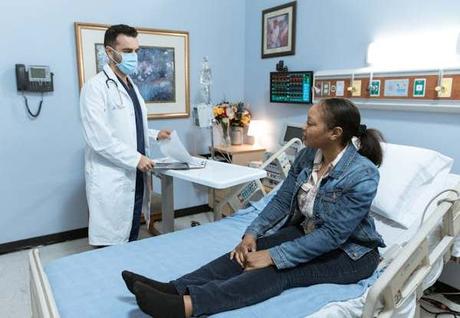
The caliper gives an accurate measurement of the gap, and doctors also check for how strong the surrounding muscles are. In some cases, they may prescribe an ultrasound, which will give a more comprehensive picture. Based on their findings, you will be prescribed certain exercises to fix your diastasis recti.
Exercises to fix Diastasis Recti
Whether you’ve self-diagnosed or got your diagnosis from the doctor, always consult a professional before starting exercises for diastasis recti. You need to ensure that the workouts you do are going to help you and not worsen your condition.
The best exercises for diastasis recti engage the deep abdominal muscles, particularly the TVA, or the transverse abdominis. Along with the abs, you also need to strengthen your diaphragm and pelvic floor. This is why exercises for diastasis recti are unlike regular workouts – they are slow and controlled, focusing on breathing and engagement.
1. Diaphragmatic breathing

- Lie down or sit in a comfortable position with your back straight
- Place one hand on your belly and the other on your chest
- Inhale deeply through the nose, sending the air into your belly – your stomach should rise
- Exhale through the mouth with a ‘shh’ sound, emptying your belly of air and tightening your abs as you do so
2. Abdominal bracing
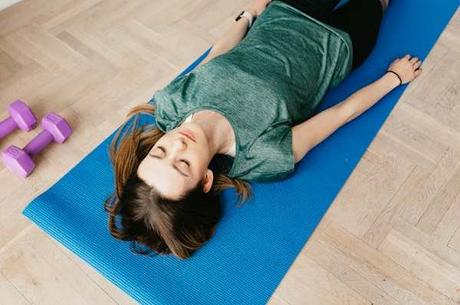
- Lie down on your back and try to anchor your lower back to the floor – bend your knees if needed
- Inhale and as you exhale, draw your belly button in towards your spine – feel your abs brace and tighten
- Hold for 5-10 seconds and release
- Repeat 5-10 times
3. Pelvic tilts
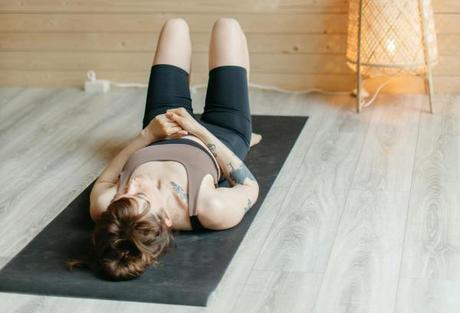
- Lie down on your back with your knees bent and feet flat on the floor
- Push your lower back into the floor, flattening it against the floor and tilting your pelvis backward
- Hold for 5 seconds and release
- Repeat 5-10 times
4. Umbrella Breathing with Kegel
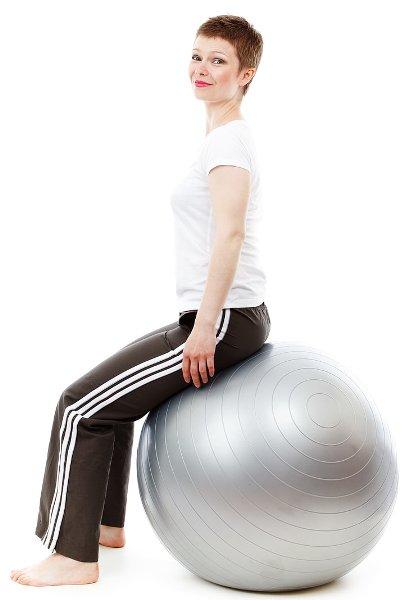
- Sit on a yoga ball or a chair so that your thighs are parallel to the floor and your feet are flat on the floor
- Inhale deeply, imagining your ribcage to be an umbrella opening
- As you exhale, empty your belly, engaging your abdominal muscles and lifting up your pelvic floor as if you are trying to stop the flow of urine – that counts as a kegel
5. Pelvic tilts on all fours
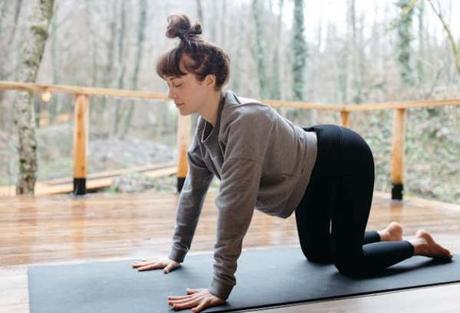
- Get down in a tabletop position, with your hands and the tops of your feet on the floor
- Keep wrists under the shoulders and knees under the hips; head and back should be neutral
- Inhale deeply into the sides of your torso
- Exhale as you curl your spine down and lift your chest
- Inhale and return to neutral
6. Kneeling leg and arm extension

- Get down in a tabletop position, with your hands and the tops of your feet on the floor
- Keep wrists under the shoulders and knees under the hips; head and back should be neutral
- Exhale and engage your core by drawing your navel up toward your spine
- As you inhale, stretch out your right arm in front and your left leg behind
- Exhale and return to neutral. Repeat on the opposite side
7. Side plank
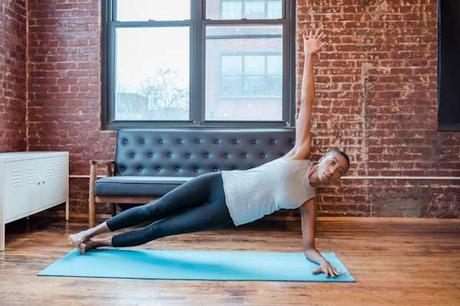
- Lie down on your right side and prop up your upper body by supporting yourself on your right forearm
- The right elbow should be directly under the right shoulder and left leg stacked on top of the right one
- There should be a straight line from your heels to the crown of your head
- Hold the pose for 15 seconds while breathing normally and release. Repeat on the other side
8. Heel taps with weights
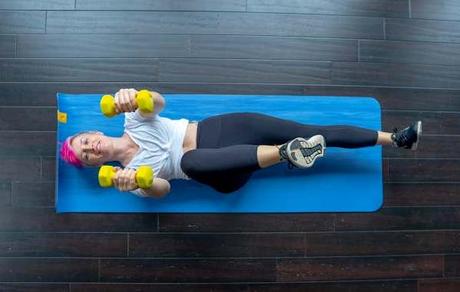
- Lie down on your back with your knees bent and feet flat on the floor
- Hold light weights or water bottles in your hands
- Lift your feet so that your knees are directly over the hips and calves are parallel to the floor
- Start with your arms bent at the elbow and palms facing each other
- Inhale into your ribcage and as you exhale, extend the right leg so the right heel touches the floor
- At the same time, lift your weights straight up. Make sure your core is engaged throughout
- Inhale as you bring your arms and the right leg back to the starting position
- Repeat with the left leg
9. Leg lifts
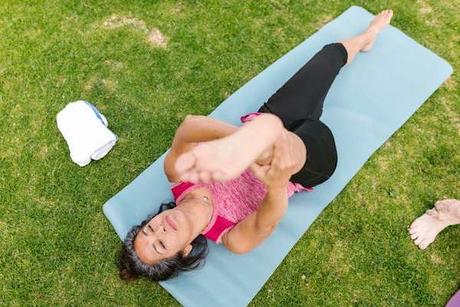
- Lie down on your back with your knees bent and feet flat on the floor
- Inhale deeply, filling your belly with air
- As you exhale and empty your belly, engage your core and lift the right foot, straightening the knee and extending the leg as much as you can
- Inhale and lower the leg to the starting position. Repeat on the other side
10. Glute bridge
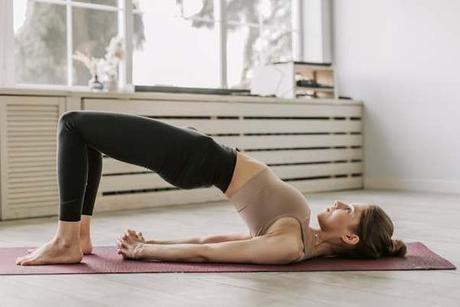
- Lie down on your back with your knees bent and feet flat on the floor
- Press your heels firmly into the floor and keep your shoulders down
- Tuck your chin into your chest and use your grounded heels to help lift your pelvis off the floor
- Squeeze your glutes for a few seconds and lower your hips slowly to the floor
Make sure you avoid these exercises when healing your diastasis recti:
- Sit-ups and crunches
- Oblique curls and reverse curls
- Traditional planks
- Backbends or spinal extensions
- Yoga poses like boat pose or downward dog
- Pilates moves like scissor legs or double leg lifts
- High-intensity exercises like HIIT, Tabata or burpees
- Exercises with heavy weights
- Any exercise that causes the belly to bulge outward
Remember to always start slow and light and then increase the difficulty or weights as you get stronger. Once you are healed, you can try more intensive yoga or pilates to strengthen your ab muscles further.
Other tips to heal Diastasis Recti

- As you go about your day, practice diaphragmatic breathing and abdominal bracing to strengthen the abs
- Don’t lift anything heavier than your baby
- When holding your baby, avoid putting all the weight on one hip
- When getting out of bed, bend your knees, roll to your side and bring yourself up using your arm for support
- Practice good posture while sitting or standing – a back brace or abdominal brace can help
- Place a soft pillow under or behind your lower back for support
- Support or engage your ab muscles when coughing or sneezing
Please remember that belly bands don’t really help with diastasis recti. You need to really target the inner muscles to strengthen and heal them, which can only be done with exercise. The best thing, of course, is to take steps to prevent it in the first place!
Prevention of Diastasis Recti

- Maintain a healthy weight throughout pregnancy by focusing on healthy foods and avoiding high-calorie junk
- Always practice proper posture when sitting, standing or lying down
- Start practicing deep breathing exercises as early as you can
- Avoid putting pressure on your ab muscles after the first trimester
- Don’t lift very heavy weights, and always bend your knees and use your legs to do any lifting
- Always get out of bed by rolling onto one side instead of crunching up
Treatment of Diastasis Recti
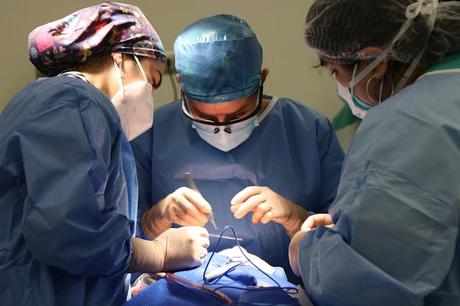
The majority of diastasis recti cases can be fixed through regular exercises and good posture. It is recommended not to ignore your diastasis recti because if left untreated, it can lead to complications like:
- Severe pain in the back and pelvis
- Compromised core strength and stability
- Poor posture and functional mobility
- Pelvic floor dysfunction
- Uncomfortable or painful sex
- Umbilical hernia
If your diastasis recti is too severe or isn’t healing with exercise, you may require surgery, although this is quite rare. Surgery is usually done for a hernia or as part of a tummy tuck. Even if you’ve recovered from diastasis recti once, you can get it again the next time you get pregnant. However, by following our tips early on, you can prevent it from occurring at all!

Buy Healthy Nutritious Baby, Toddler food made by our own Doctor Mom !
Shop now!You may also like
- Top 10 Effective Home Remedies for Diarrhea in…

- Exploring Side Effects of Rotavirus Vaccine:…

- 20 Home Remedies with Spices from your Kitchen

- 5 Home Remedies To Get Rid Of Head Lice

- 8 Effective Home Remedies for Bug Bites

- 12 Natural Remedies for Baby Eczema

Filed Under: Moms
